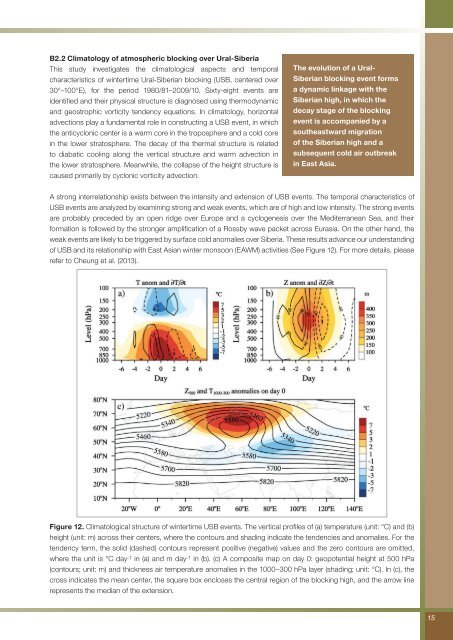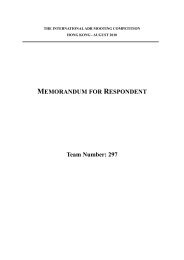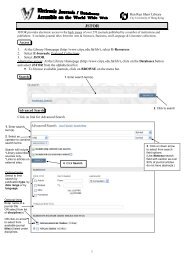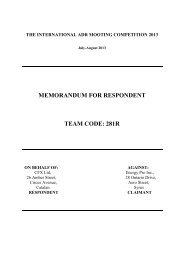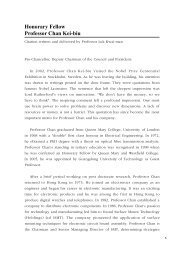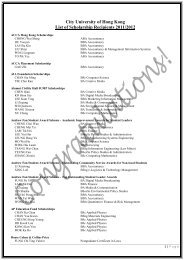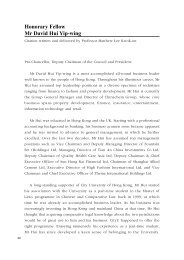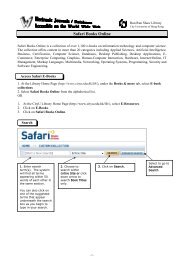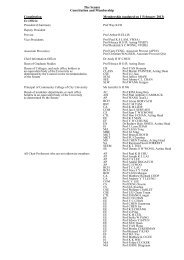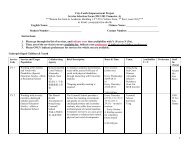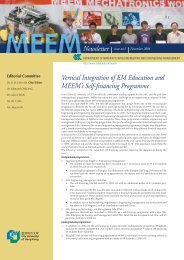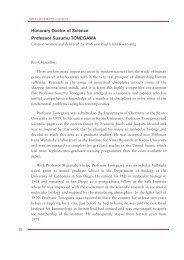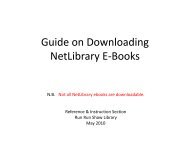Annual Report 2012 - City University of Hong Kong
Annual Report 2012 - City University of Hong Kong
Annual Report 2012 - City University of Hong Kong
You also want an ePaper? Increase the reach of your titles
YUMPU automatically turns print PDFs into web optimized ePapers that Google loves.
B2.2 Climatology <strong>of</strong> atmospheric blocking over Ural-Siberia<br />
This study investigates the climatological aspects and temporal<br />
characteristics <strong>of</strong> wintertime Ural-Siberian blocking (USB, centered over<br />
30°–100°E), for the period 1980/81–2009/10. Sixty-eight events are<br />
identified and their physical structure is diagnosed using thermodynamic<br />
and geostrophic vorticity tendency equations. In climatology, horizontal<br />
advections play a fundamental role in constructing a USB event, in which<br />
the anticyclonic center is a warm core in the troposphere and a cold core<br />
in the lower stratosphere. The decay <strong>of</strong> the thermal structure is related<br />
to diabatic cooling along the vertical structure and warm advection in<br />
the lower stratosphere. Meanwhile, the collapse <strong>of</strong> the height structure is<br />
caused primarily by cyclonic vorticity advection.<br />
A strong interrelationship exists between the intensity and extension <strong>of</strong> USB events. The temporal characteristics <strong>of</strong><br />
USB events are analyzed by examining strong and weak events, which are <strong>of</strong> high and low intensity. The strong events<br />
are probably preceded by an open ridge over Europe and a cyclogenesis over the Mediterranean Sea, and their<br />
formation is followed by the stronger amplification <strong>of</strong> a Rossby wave packet across Eurasia. On the other hand, the<br />
weak events are likely to be triggered by surface cold anomalies over Siberia. These results advance our understanding<br />
<strong>of</strong> USB and its relationship with East Asian winter monsoon (EAWM) activities (See Figure 12). For more details, please<br />
refer to Cheung et al. (2013).<br />
Figure 12. Climatological structure <strong>of</strong> wintertime USB events. The vertical pr<strong>of</strong>iles <strong>of</strong> (a) temperature (unit: °C) and (b)<br />
height (unit: m) across their centers, where the contours and shading indicate the tendencies and anomalies. For the<br />
tendency term, the solid (dashed) contours represent positive (negative) values and the zero contours are omitted,<br />
where the unit is °C day -1 in (a) and m day -1 in (b). (c) A composite map on day 0: geopotential height at 500 hPa<br />
(contours; unit: m) and thickness air temperature anomalies in the 1000–300 hPa layer (shading; unit: °C). In (c), the<br />
cross indicates the mean center, the square box encloses the central region <strong>of</strong> the blocking high, and the arrow line<br />
represents the median <strong>of</strong> the extension.<br />
The evolution <strong>of</strong> a Ural-<br />
Siberian blocking event forms<br />
a dynamic linkage with the<br />
Siberian high, in which the<br />
decay stage <strong>of</strong> the blocking<br />
event is accompanied by a<br />
southeastward migration<br />
<strong>of</strong> the Siberian high and a<br />
subsequent cold air outbreak<br />
in East Asia.<br />
15


